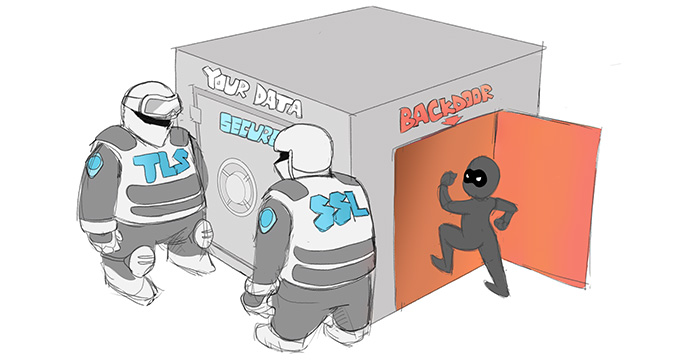
Backdoor the soul hacker
A backdoor is a typically covert method of bypassing normal authentication or encryption in a computer, product, embedded device (e.g. a home router), or its embodiment (e.g. part of a cryptosystem, algorithm, chipset, or even a "homunculus computer" tiny computer-within-a-computer such as that found in Intel's AMT technology). Backdoors are most often used for securing remote access to a computer, or obtaining access to plaintext in cryptographic systems. From there it may be used to gain access to privileged information like passwords, corrupt or delete data on hard drives, or transfer information within auto schediastic networks.
A backdoor may take the form of a hidden part of a program, a separate program (e.g. Back Orifice may subvert the system through a rootkit), code in the firmware of the hardware, or parts of an operating system such as Windows. Trojan horses can be used to create vulnerabilities in a device. A Trojan horse may appear to be an entirely legitimate program, but when executed, it triggers an activity that may install a backdoor. Although some are secretly installed, other backdoors are deliberate and widely known. These kinds of backdoors have "legitimate" uses such as providing the manufacturer with a way to restore user passwords.
Many systems that store information within the cloud fail to create accurate security measures. If many systems are connected within the cloud, hackers can gain access to all other platforms through the most vulnerable system.
Default passwords (or other default credentials) can function as backdoors if they are not changed by the user. Some debugging features can also act as backdoors if they are not removed in the release version.
In 1993, the United States government attempted to deploy an encryption system, the Clipper chip, with an explicit backdoor for law enforcement and national security access. The chip was unsuccessful.
Overview
The threat of backdoors surfaced when multiuser and networked operating systems became widely adopted. Petersen and Turn discussed computer subversion in a paper published in the proceedings of the 1967 AFIPS Conference.[12] They noted a class of active infiltration attacks that use "trapdoor" entry points into the system to bypass security facilities and permit direct access to data. The use of the word trapdoor here clearly coincides with more recent definitions of a backdoor. However, since the advent of public key cryptography the term trapdoor has acquired a different meaning (see trapdoor function), and thus the term "backdoor" is now preferred, only after the term trapdoor went out of use. More generally, such security breaches were discussed at length in a RAND Corporation task force report published under ARPA sponsorship by J.P. Anderson and D.J. Edwards in 1970.[13]
A backdoor in a login system might take the form of a hard coded user and password combination which gives access to the system. An example of this sort of backdoor was used as a plot device in the 1983 film WarGames, in which the architect of the "WOPR" computer system had inserted a hardcoded password which gave the user access to the system, and to undocumented parts of the system (in particular, a video game-like simulation mode and direct interaction with the artificial intelligence).
Although the number of backdoors in systems using proprietary software (software whose source code is not publicly available) is not widely credited, they are nevertheless frequently exposed. Programmers have even succeeded in secretly installing large amounts of benign code as Easter eggs in programs, although such cases may involve official forbearance, if not actual permission.
A countermeasure against backdoors is open-source software, where the source code can be examined for potential backdoors and it is as such usually harder to ″hide″ a backdoor in there. Combined with reproducible builds one can also be sure that a provided binary corresponds to the publicly available source code
Countermeasures
Once a system has been compromised with a backdoor or Trojan horse, such as the Trusting Trust compiler, it is very hard for the "rightful" user to regain control of the system – typically one should rebuild a clean system and transfer data (but not executables) over. However, several practical weaknesses in the Trusting Trust scheme have been suggested. For example, a sufficiently motivated user could painstakingly review the machine code of the untrusted compiler before using it. As mentioned above, there are ways to hide the Trojan horse, such as subverting the disassembler; but there are ways to counter that defense, too, such as writing your own disassembler from scratch.
A generic method to counter trusting trust attacks is called Diverse Double-Compiling (DDC). The method requires a different compiler and the source code of the compiler-under-test. That source, compiled with both compilers, results in two different stage-1 compilers, which however should have the same behaviour. Thus the same source compiled with both stage-1 compilers must then result in two identical stage-2 compilers. A formal proof is given that the latter comparison guarantees that the purported source code and executable of the compiler-under-test correspond, under some assumptions. This method was applied by its author to verify that the C compiler of the GCC suite (v. 3.0.4) contained no trojan, using icc (v. 11.0) as the different compiler.[24]
In practice such verifications are not done by end users, except in extreme circumstances of intrusion detection and analysis, due to the rarity of such sophisticated attacks, and because programs are typically distributed in binary form. Removing backdoors (including compiler backdoors) is typically done by simply rebuilding a clean system. However, the sophisticated verifications are of interest to operating system vendors, to ensure that they are not distributing a compromised system, and in high-security settings, where such attacks are a realistic concern.





